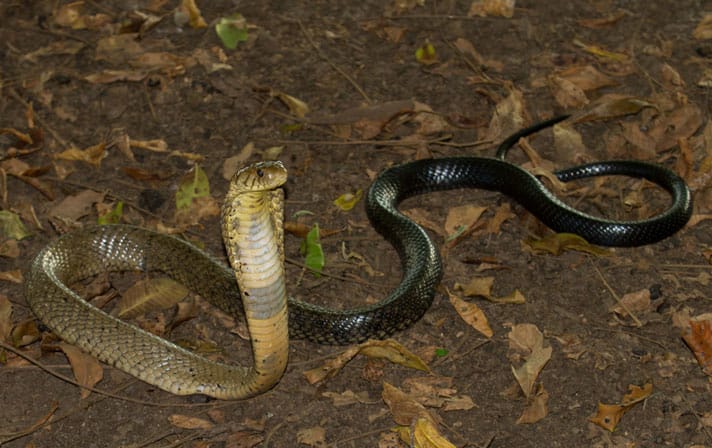A professor and his colleagues seek to expand cobra research in Central Africa.
The list of dangerously venomous snakes in Africa is long, and includes boomslangs (Dispholidus), twig snakes (Thelotornis), stilleto snakes (Atractaspis), mambas (Dendroaspis), and several genera of vipers. It’s the 19 currently recognized species of cobras, however, including members of the genera Naja, Pseudohaje, and Hemachatus, that are undoubtedly the continent’s most iconic snakes, because their hood-spreading warning is unmistakable, and their venom is extremely powerful. Some of Africa’s cobras have even evolved the ability to “spit” at potential predators by forcing a fine jet of venom through a hole in their fangs, usually targeted at the eyes of their tormentors and which can cause painful burning and blindness if left untreated. Even the lion, renowned as Africa’s king of beasts, has been known to shy away from these intimidating and majestic snakes.
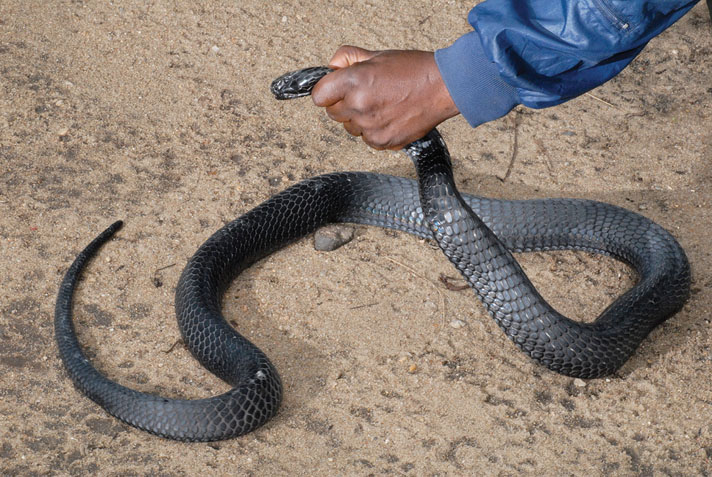
eli greenbaum
This black-necked spitting cobra (N. n. atriceps) was found in Burundi. DNA samples collected from the snakes were used to help understand the relationships of different African snake populations to each other.
Challenges of Herping the Congo
I have worked as a herpetologist in Central Africa (Burundi, Uganda and the Democratic Republic of the Congo) over the last decade, and one might think that venomous snakes would be the most dangerous hazard there, especially considering that most of the hospitals are not equipped with antivenom to treat serious bites — not to mention they often lack electricity and running water.
In fact, tropical diseases are the most significant risk, including potentially deadly infections from malaria, dengue fever, Ebola, sleeping sickness, river blindness, plague, Marburg virus, typhoid fever, monkeypox and my personal favorite, Satan’s fever.
In regard to the Congo, there are many other problems, too, because the country’s dictator, Mobutu Sese Seko, stole billions of dollars from the national coffers during three decades of rule when the country was called Zaïre (from 1971 to 1997). This extensive corruption trickled down through all levels of government, an unfortunate mindset that continues to this day, and it led to a steady deterioration of the country’s infrastructure, including roads, bridges, sanitation, electrical grids, health facilities, schools and universities, and many other important services and institutions that had been in excellent condition during the colonial era in the first half of the 20th century.
As a result, transportation in the Congo is now extremely challenging, and I have spent countless hours trying to navigate crumbling bridges over crocodile-infested rivers; roads that pass through flooded swamps with enormous pits of sludge-like mud; and unpaved “national highways” that haven’t been maintained for 50 years, thus resembling barely visible hiking trails through remote stretches of thick vegetation, complete with hidden pits that are large enough to overturn a truck if one is not careful. Simple problems like a flat tire have left me stranded for a week or more in remote areas when I was too far away from a garage to obtain repairs that would require 10 minutes of work under normal circumstances.
As if all this were not troublesome enough, consider that the Congo is still recovering from Africa’s World War, a conflict you have probably never heard of due to the lack of Western media coverage while it was raging from 1998 to 2003. It was the deadliest conflict since World War II, and some areas are still covered in land mines and unexploded ordnance. Many of the armed groups who were involved in it, too, including the dreaded Interahamwe (responsible for much of the Rwandan genocide in 1994), continue to wreak havoc in the remote jungles of the eastern Congo, where I have spent the majority of my time looking for new species of herps.
Herpetological Fieldwork in the Congo
As you can imagine, few biologists are willing to face these daunting challenges and, in fact, very little herpetological fieldwork has occurred in the Congo since the end of the colonial era. Prior to the violent demise of the Belgian Congo in 1960, two Belgian herpetologists named Gaston-François de Witte and Raymond F. Laurent spent decades exploring the Congo’s beautiful rain forest, savanna and bamboo landscapes in search of unknown amphibians and reptiles, and the vast majority of the published literature about the country’s herpetofauna was written by them. Without the advantage of DNA sequence data to guide their taxonomic decisions, de Witte and Laurent relied almost exclusively on morphology (size, shape, scale counts, etc.) to distinguish new species of herps, and in some cases, new subspecies that had minor morphological differences, including color pattern.
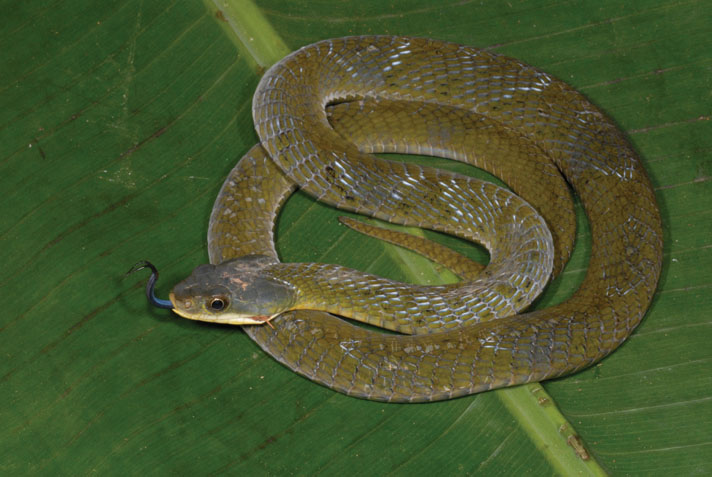
eli greenbaum
Cobras were not the only herps found during the trip. This forest night adder (Causus lichtensteini), with a blue tongue, was encountered in the Ituri region.
When I began my field program in the Congo in 2007, I was very eager to observe the herpetological species and subspecies that had been named by the Belgians, because in most cases, no professional herpetologist had seen them for half a century, no color photos existed, and given the extensive deforestation and other widespread habitat damage in the region, it was possible some of them could have gone extinct. Moreover, I wanted to use 21st-century methods with DNA sequence data to test the validity of the species and subspecies that were named by the Belgians. Were they actually distinct species on their own evolutionary path, or were they actually minor color variants of the same species, analogous to humans with brown versus blonde hair? I was really eager to find out, especially in regard to the country’s venomous snakes.
In 1956, Laurent wrote Contribution à L’Herpétologie de la Région des Grands Lacs de l’Afrique centrale. I. Généralités, II. Chéloniens, III. Ophidiens (Musée Royal du Congo Belge), a well-illustrated, 390-page opus on the turtles and snakes of the Great Lakes region of Africa on the Congo’s eastern border. Along with several descriptions of new species and subspecies, Laurent did an extensive evaluation of the region’s cobras, including the black-necked spitting cobra (Naja nigricollis), a common resident of non-forested habitats in Central Africa. Three subspecies were considered: the nominate form (N. n. nigricollis) in “Sudanese savanna” of the northeastern Congo, distinguished by 23 to 25 scale rows; N. n. crawshayi in the Ruzizi Plain (connecting lakes Kivu and Tanganyika) to southeastern Congo, distinguished by 17 to 21 dorsal scale rows, 177 to 186 ventrals, and a “pale” brown head; and N. n. atriceps in the Nile Drainage basin of North Kivu Province, Congo to Rwanda and Burundi, distinguished by 17 to 21 dorsal scale rows, 191 to 206 ventrals, and a black head.
Spitting Cobras are Impressive Spitters
I was anxious to find out whether Laurent’s three spitting cobra subspecies were really distinct, but I also knew I had to collect specimens very carefully. Reaching about 6 feet in length, black-necked spitting cobras can move rapidly and are infamous for their willingness to bite or spray venom from up to about 10 feet away into the eyes of anything or anyone threatening them. The venom has a nasty combination of cytotoxic (cell-destroying) and neurotoxic (damaging to nerve tissue) properties that can result in truly horrific and deadly damage to the human body.
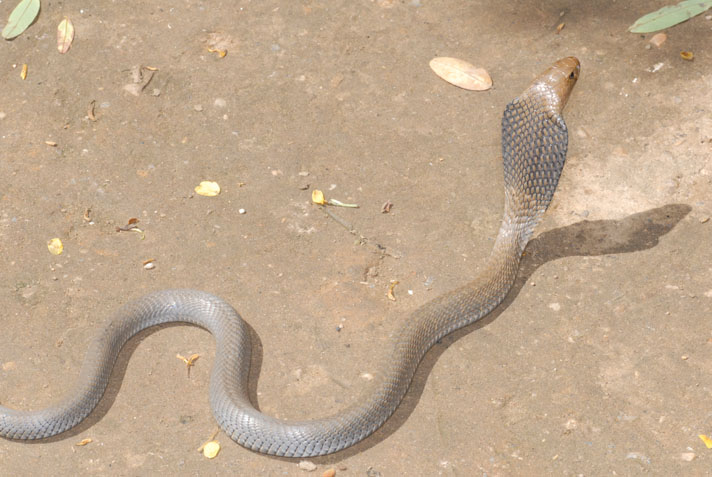
eli greenbaum
This is the black-necked spitting cobra (N. n. crawshayi) that sprayed venom into the eye of Wandege Muninga, one of the author's Congolese colleagues.
In the case of N. n. atriceps, Laurent recounted an encounter with an enormous individual that was discovered under the roots of a tree: “Our efforts to dislodge it were not rewarded, because the snake risked a sudden break for freedom, which left me and my hunters stunned, and the cobra, crowned with success, disappeared into the grass like a bolt of lightning.”
Black-necked spitting cobras prey on toads, snakes and lizards, including monitor lizards, but they will also eat chickens and their eggs if they can find them around villages.
As explained in further detail in my book, Emerald Labyrinth, my first run-in with a spitting cobra in the Congo did not go so well. A group of villagers had heard that we were looking for reptiles and took it upon themselves to corner a subadult spitter near the village of Kamanyola in the Ruzizi Plain, where N. n. crawshayi occurs. After admonishing the men to never repeat this dangerous stunt, my Congolese colleague, Wandege Muninga, was helping his 80-year old mentor, Maurice Luhumyo, restrain the animal when Wandege made the mistake of stepping in front of the cobra’s face.
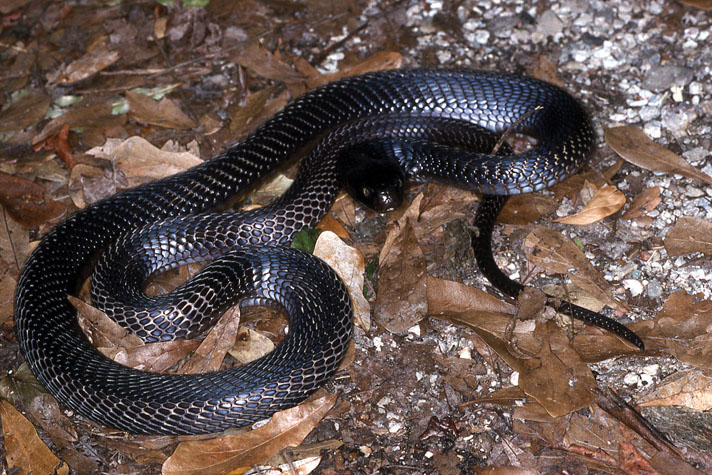
eli greenbaum
Spitting cobras (Naja nigricollis) usually target the eyes of their tormentors, spraying a jet of venom through a hole in their fangs.
The snake unleashed a perfectly aimed stream of venom into Wandege’s eye. We immediately rinsed his eye with water, provided ibuprofen and painkillers, gave him a potion made from the katumbanyi plant, supposedly with antivenomous properties, and even bathed his eye in some breast milk from a local mother, but nothing seemed to help the horrible pain. By the next morning his eye swelled to such a degree that he appeared to have lost a fistfight, but luckily, within a few days, it returned to normal with no permanent loss of vision.
Two years after Wandege’s unfortunate encounter, another Congolese colleague, Chifundera Kusamba, arranged for us to get a DNA sample from the tail of an enormous N. n. atriceps that was housed at a zoo in Burundi. Later, with these rare samples in hand, I worked with students in my evolutionary genetics laboratory at the University of Texas at El Paso (UTEP) to sequence a commonly used fragment of DNA called 16S, which encodes an important stretch of RNA in ribosomes that is used in the critically important biological process of translation (synthesis of proteins) in all living organisms. When we analyzed the results, we found only modest genetic differences between the three subspecies of spitting cobras, but increased sampling from across Africa will be required to know with certainty if they should be lumped together into the same widespread and morphologically variable species known as Naja nigricollis.
African Forest Cobras
The other interesting group of snakes covered in Laurent’s 1956 paper are the forest cobras (N. melanoleuca ssp.). The nominate form, N. m. melanoleuca, is supposedly widespread throughout Central Africa’s rain forests, has a mostly black venter, a completely black dorsum, 211 to 221 ventrals in males and 219 to 226 ventrals in females.
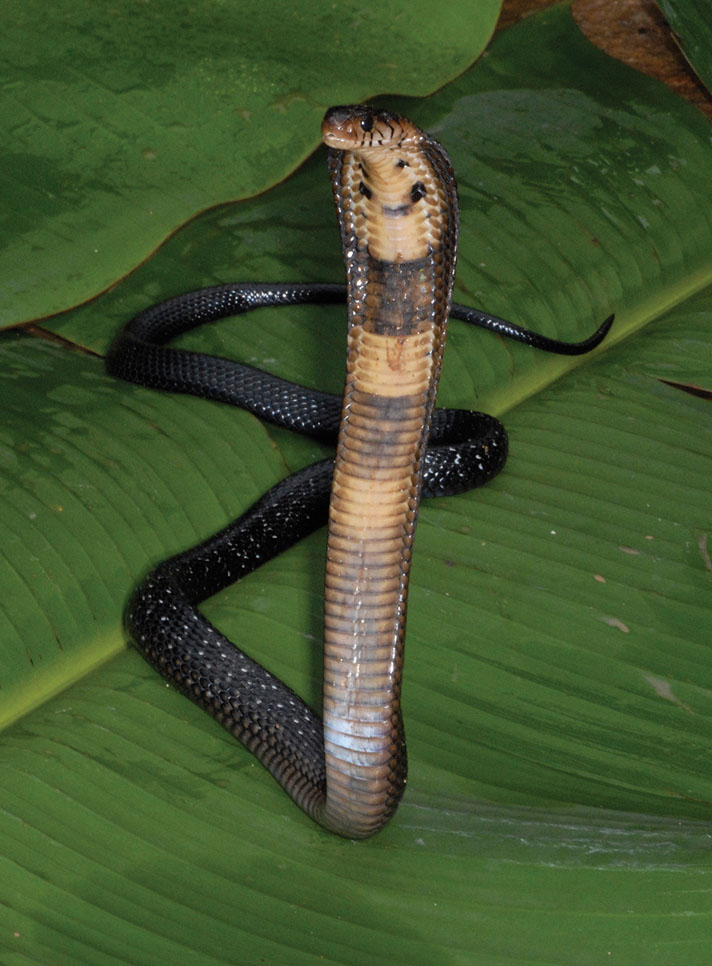
eli greenbaum
This subadult forest cobra (Naja melanoleuca subfulva) was brought to the author by a pygmy hunter in Burundi.
In an earlier publication, Laurent named the subspecies Naja melanoleuca subfulva (the subspecies name means “yellow underneath”), a cobra that is found in the non-forested habitats of the eastern Congo, and distinguished by its yellowish belly, beige to brownish black dorsum, 203 to 211 ventrals in males and 208 to 218 ventrals in females.
African forest cobras can often reach lengths of about 10 feet. Although they are usually terrestrial, they occasionally hunt for amphibians and fish so extensively that they can be considered semiaquatic. But they will also climb 30 feet or more into trees in search of birds, bird eggs, other snakes, monitor lizards, rodents and other mammals.
Although few forest cobra bites are known, a child who was bitten in Liberia died within 20 minutes, most likely from copious amounts of the potent neurotoxic venom. Keepers who have cared for forest cobras in captivity describe them as the most dangerous African snake because they are alert, quick, intelligent and very aggressive — some cunning individuals seemed to time their escape attempts perfectly during brief lapses of concentration by their keepers, whereas others were more determined to bite their captors than escape.
Over the years, I have collected several forest cobras in the eastern Congo and Burundi, but most of the time these were road-killed specimens that we happened to spot while traveling between field sites. One notable exception occurred while our truck was stuck with a flat tire in several feet of mud, seemingly for the millionth time, on a terrible road passing through the bamboo-dominated rain forest of the Ituri region of the northeastern Congo.
My graduate student, Danny Hughes, was with me, and while I dodged dive-bombing wasps from a nearby nest to help extract our truck, Danny decided to follow a hunter into the forest to see about a cobra that the man claimed to have caught in a trap. Apparently, the man had set a snare trap to catch small rodents, a common practice throughout Central Africa, but an enormous cobra had come across a trapped rat in the snare, eaten it, and then became caught in the snare itself. I was convinced Danny was going off on a wild goose chase, and so was completely shocked when he returned an hour later with a 9-foot forest cobra. It seemed to be the typical forest form.
Because the region along the eastern Congo’s border has one of the highest human population densities in the world, especially in neighboring Rwanda and Burundi, extensive deforestation has occurred in recent decades, and none of the “forest cobras” I have found there seemed to match the typical form. However, the savanna subspecies described by Laurent, N. m. subfulva, popped up from time to time, sometimes under surprising circumstances.
One time, while exploring a village on the edge of Kibira National Park in Burundi, I was approached by an old pygmy man. Central African pygmies, of course, are famous the world over as indigenous hunter-gatherers of relatively small stature. Barefoot, with frazzled hair, a patchwork of several threadbare garments that had been stitched together for clothes, and a smoky handmade pipe dangling from his mouth, the man mumbled, “Nyoka” — the Swahili word for snake.
“Ndiyo!” I exclaimed (meaning “yes”), smiling widely in anticipation of an interesting capture. In Central Africa, the presence of friendly pygmies usually ensured that I would see some interesting snakes. This was because pygmies know the forest like the backs of their hands. They made excellent guides and knew exactly where to find the rarest herps, sometimes telling me that they knew where a particular snake or very rare species of toad lived in a burrow that they happened to pass every day while hunting antelope.
When the old pygmy produced a thick piece of bamboo with several leaves stuffed into the ends of it, I wasn’t sure what would hop, crawl or slither out. Then he exchanged a few words in his native language with my Congolese colleague, Mwenebatu Aristote, and I was warned that he had found a young cobra.
The entire village formed a circle around us as the man placed the bamboo on the ground before us, and several people shrieked in fear as a subadult cobra emerged from the bamboo, hood spread and angry. At this age it is difficult to distinguish the typical forest cobra form from the savanna cobra, because they both have grayish black bodies with white flecks and spots, and only the adults develop the more yellowish coloration that is typical for N. m. subfulva. The snake was restrained, and I was able to procure DNA samples.
New Species Of Forest Cobra
Eventually, the DNA samples that I obtained from the forest cobras mentioned here, as well as several others, were combined with many samples from other areas of Africa to understand the relationships of the different populations of snakes to each other. In collaboration with the late Donald Broadley, who had amassed an enormous amount of scale count and measurement data from hundreds of museum specimens, and Wolfgang Wüster, one of the world’s most prominent authorities on cobras, a surprising picture started to emerge.
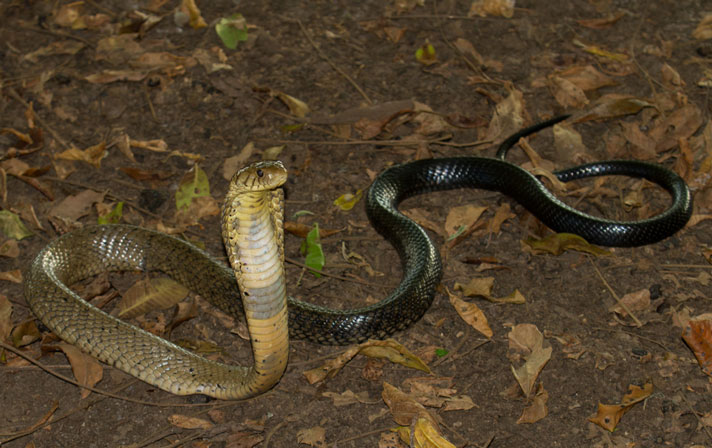
Andre Coetzer/Shutterstock
African forest cobras can often reach lengths of about 10 feet.
Laurent’s N. m. subfulva seems to be a valid species, which isn’t surprising given its distinct habitat preference, scale counts and coloration. Perhaps more surprising was the discovery of at least one cryptic species — distinct species that look identical based on color pattern and other morphological characters, but are completely distinct based on DNA sequence data.
Several colleagues and I hope to publish these findings in the near future. Moreover, in September 2017, Luis Ceríaco and colleagues published a paper describing a new species of forest cobra, N. peroescobari, from the island of São Tomé (see Ceríaco, L. M. P., M. P. Marques, A. Schmitz, and A. M. Bauer. 2017. “The ‘Cobra-preta’ of São Tomé Island, Gulf of Guinea, is a new species of Naja Laurenti, 1768 [Squamata: Elapidae].” Zootaxa 4324:121–141). This suggests more new cobra species may be hiding in unexplored corners of Africa.
Surprising and exciting findings such as these are likely to draw me back repeatedly to the most remote jungles of the Congo. Who knows how many unknown snake species are slithering through Central Africa at this very moment? With luck, I will find at least some of them!
Thanks to Kate Jackson for assistance in translating parts of Laurent’s paper. The research and expeditions discussed in this article were funded by National Geographic (Research and Exploration Grant no. 8556-08) and the US National Science Foundation (DEB-1145459).
Eli Greenbaum is an associate professor of evolutionary genetics at the University of Texas at El Paso, with a research focus on the herpetology of Central Africa. He has published more than 100 articles in peer-reviewed, scientific journals, and his work has been featured in msnbc.com, NationalGeographic.com, Africa Geographic Magazine and The Huffington Post. His book, Emerald Labyrinth: A Scientist’s Adventures in the Jungles of the Congo, was published by University Press of New England in November 2017 (upne.com/1512600971.html). Check out his video, Emerald Abyss: 9 Years of Research in the Congo, at http://bit.ly/2xEfGhf.

